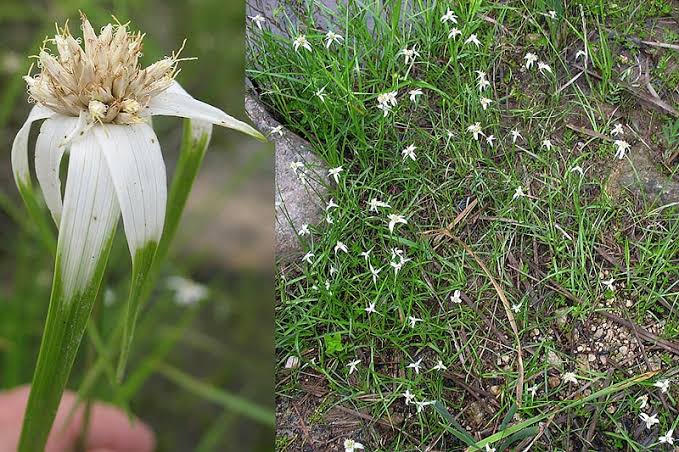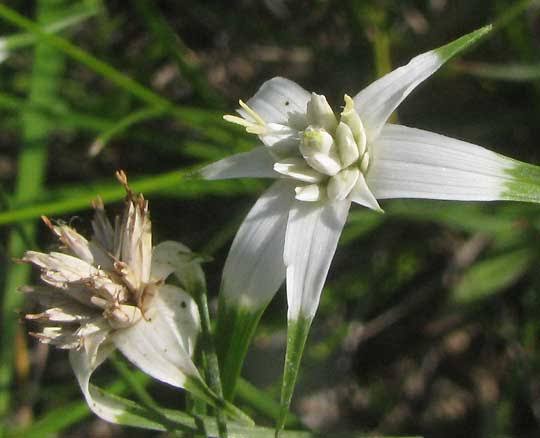Whitetop sedge (Rhynchospora colorata) is a lovely plant that grows in wetlands, bringing beauty to its surroundings. This plant is known for its tall stems topped with white tufted flowers, creating a picturesque scene in marshy areas.
In terms of appearance, Whitetop sedge has slender green leaves and a distinctive flowering structure. The plant reaches heights of around three feet, with its delicate white blooms adding a touch of elegance to the wetland landscape.
One fascinating aspect of Whitetop sedge is its adaptability to various soil conditions. It thrives in moist to wet soils, making it a common sight in marshes, bogs, and along the edges of ponds and streams. This adaptability is due to the plant’s unique ability to tolerate both standing water and periodic dry spells.
Beyond its aesthetic appeal, Whitetop sedge plays a crucial role in supporting local ecosystems. Its dense growth provides shelter and nesting sites for birds, while also offering refuge to various aquatic organisms. Additionally, the plant contributes to soil stabilization, helping to prevent erosion in wetland areas.
Interestingly, Whitetop sedge has been utilized by some indigenous communities for traditional purposes. While not extensively documented, it is known that certain groups have employed parts of the plant for crafting, weaving, or medicinal applications. These traditional uses highlight the plant’s cultural significance and the diverse ways in which humans interact with their natural environment.
Conservation efforts often focus on preserving wetland habitats, recognizing the importance of plants like Whitetop sedge in maintaining the delicate balance of these ecosystems. The plant’s ability to filter water and provide habitat for diverse wildlife underscores its ecological value.
In addition, Whitetop sedge is not just a charming addition to wetland landscapes; it is a resilient and vital component of these ecosystems. Its simple yet elegant appearance, adaptability, and ecological contributions make it a plant worth appreciating and safeguarding for the benefit of both nature and human communities.
Read Also: Are Honey Bees Endangered?
How To Grow Whitetop Sedge (Rhynchospora colorata)

Growing Whitetop sedge (Rhynchospora colorata) can be a rewarding experience, especially for those looking to enhance wetland areas or create a unique garden setting. Here’s a straightforward guide on how to grow this lovely plant:
1. Choose the Right Location: Select a location that mimics the natural habitat of Whitetop sedge. This plant thrives in moist to wet soils, so consider areas near ponds, streams, or low-lying spots in your garden. Ensure the site receives adequate sunlight, as Whitetop sedge generally prefers full to partial sun.
2. Soil Preparation: Whitetop sedge is adaptable to various soil types, but it does best in well-draining, slightly acidic to neutral soils. Amend the soil with organic matter, such as compost, to improve fertility and moisture retention.
3. Planting: If you’re starting with seeds, sow them directly on the soil surface and lightly press them into the soil. Water thoroughly after planting. If you have established plants, space them according to their mature size, allowing enough room for them to spread.
4. Watering: Keep the soil consistently moist, as Whitetop sedge prefers a wet environment. Water regularly, especially during dry spells, to mimic its natural habitat conditions. Avoid waterlogged conditions, as excessive standing water can be detrimental.
5. Mulching: Apply a layer of mulch around the plants to help retain moisture and suppress weeds. This is particularly important during the initial stages of growth. Use organic mulch to enrich the soil over time.
6. Maintenance: Whitetop sedge is relatively low-maintenance. Prune dead or damaged foliage as needed. If the plant becomes too dense, thin it out to promote air circulation. In the right conditions, Whitetop sedge can form attractive clumps.
7. Fertilizing: While Whitetop sedge is not heavy feeder, you can apply a balanced, slow-release fertilizer in spring to encourage healthy growth. Follow the recommended dosage on the fertilizer packaging.
8. Wildlife Considerations: If you’re interested in attracting wildlife, such as birds, to your garden, leave some areas of the Whitetop sedge undisturbed. The plant provides valuable habitat and food sources for various creatures.
By following these simple steps, you can successfully grow Whitetop sedge and enjoy its beauty while contributing to a thriving and diverse ecosystem in your garden.
How To Care For Whitetop Sedge (Rhynchospora colorata)
Caring for Whitetop sedge (Rhynchospora colorata) involves providing the right conditions to support its natural growth and ensuring it remains healthy. Here are some care guidelines for this plant:
1. Watering: Whitetop sedge thrives in moist to wet conditions, so regular watering is crucial. Keep the soil consistently moist, especially during dry spells. However, avoid waterlogging, as this can lead to root rot. Adjust your watering schedule based on the local climate and rainfall patterns.
2. Sunlight: Plant Whitetop sedge in a location that receives full to partial sunlight. While it can tolerate some shade, it generally prefers sunny conditions. Ensure that the plant gets enough light to promote healthy growth and flowering.
3. Soil Conditions: Whitetop sedge is adaptable to various soil types but prefers well-draining soil. Amend the soil with organic matter to improve fertility and moisture retention. Regularly check the soil pH, aiming for a slightly acidic to neutral range.
4. Mulching: Apply a layer of organic mulch around the base of the plant to help retain moisture, regulate soil temperature, and suppress weeds. This is especially important during the hotter months.
5. Pruning: Whitetop sedge generally requires minimal pruning. Trim away dead or damaged foliage as needed. If the plant becomes too dense, thin it out to enhance air circulation. Pruning can be done throughout the growing season.
6. Fertilizing: While Whitetop sedge is not heavy on fertilizer requirements, you can apply a balanced, slow-release fertilizer in spring. Follow the recommended dosage on the fertilizer packaging. Avoid over-fertilizing, as this can lead to excessive foliage growth at the expense of flowering.
7. Wildlife Interaction: Embrace the wildlife that Whitetop sedge attracts. Birds may use the plant for shelter or nesting, and various insects may be drawn to its flowers. Avoid using harmful pesticides that could disrupt the natural ecosystem.
8. Monitor for Pests and Diseases: Keep an eye out for any signs of pests or diseases. While Whitetop sedge is generally resistant, occasional issues may arise. If you notice problems, address them promptly with appropriate, environmentally friendly solutions.
By following these care tips, you can help ensure that your Whitetop sedge remains healthy, vibrant, and continues to contribute to the beauty of its surroundings. Regular observation and thoughtful maintenance will go a long way in nurturing this delightful plant.
Read Also: Facts About Honey Bees
The Uses of Whitetop Sedge (Rhynchospora colorata)

Whitetop sedge (Rhynchospora colorata) holds significance beyond its ornamental value, as it has been employed for various practical purposes by different communities. Here are some of the notable uses of Whitetop sedge:
1. Erosion Control: The dense growth and robust root system of Whitetop sedge make it effective in preventing soil erosion. Planting this species along water bodies or in areas prone to erosion helps stabilize the soil, reducing the risk of loss through water runoff.
2. Habitat for Wildlife: Whitetop sedge provides valuable habitat for wildlife, particularly birds and aquatic organisms. The dense clumps offer shelter and nesting sites for birds, contributing to the biodiversity of wetland ecosystems.
3. Traditional Uses: In some indigenous communities, Whitetop sedge has been utilized for traditional purposes. While specifics may vary, certain groups have incorporated parts of the plant into crafts, weaving, or for medicinal applications. These traditional uses highlight the cultural significance of the plant.
4. Wetland Restoration: Conservationists often use Whitetop sedge in wetland restoration projects. The plant’s ability to thrive in wet soils makes it a suitable candidate for reintroducing native vegetation to degraded or disturbed wetland areas.
5. Water Filtration: Whitetop sedge plays a role in water quality improvement. The plant’s roots filter impurities, helping to improve water clarity and quality in wetland environments. This natural filtration contributes to the overall health of aquatic ecosystems.
6. Aesthetic Landscaping: Beyond its ecological benefits, Whitetop sedge is cultivated for its aesthetic appeal. Landscapers and garden enthusiasts often incorporate this plant into wetland gardens, adding a touch of elegance with its tall stems and white tufted flowers.
7. Educational Purposes: Due to its adaptability and ecological importance, Whitetop sedge is sometimes used in educational settings. Learning about this plant and its role in wetland ecosystems can raise awareness about the importance of preserving these habitats.
8. Conservation Efforts: The inclusion of Whitetop sedge in conservation initiatives helps protect and restore wetland areas. Its presence contributes to the overall health and resilience of these ecosystems, supporting a diverse range of flora and fauna.
Understanding and appreciating the diverse uses of Whitetop sedge underscore its ecological and cultural significance. From conservation efforts to traditional practices, this plant plays a multifaceted role in the tapestry of natural and human landscapes.
Frequently Asked Questions (FAQs)
Q: What is Whitetop sedge (Rhynchospora colorata)?
A: Whitetop sedge is a plant known for its slender stems and distinctive white tufted flowers. It typically grows in wetland environments, adding beauty to marshy areas.
Q: Where does Whitetop sedge thrive best?
A: Whitetop sedge thrives in moist to wet soils and is commonly found in marshes, bogs, and along the edges of ponds and streams. It prefers locations with full to partial sunlight.
Q: How tall does Whitetop sedge grow?
A: Whitetop sedge can reach heights of around three feet, creating an elegant and tall presence in its surroundings.
Q: Can Whitetop sedge tolerate dry conditions?
A: While Whitetop sedge is adaptable, it generally prefers consistently moist conditions. It can tolerate periodic dry spells but thrives best in wet environments.
Q: How do I grow Whitetop sedge?
A: Plant Whitetop sedge in well-draining soil in a location that receives full to partial sunlight. Keep the soil consistently moist, especially during dry periods. Mulching and occasional fertilizing can enhance growth.
Q: Is Whitetop sedge low-maintenance?
A: Yes, Whitetop sedge is relatively low-maintenance. Prune dead or damaged foliage as needed, thin out dense growth, and provide regular water to keep the plant healthy.
Q: What wildlife does Whitetop sedge attract?
A: Whitetop sedge attracts birds, offering them shelter and nesting sites. Additionally, various insects may be drawn to its flowers, contributing to the local ecosystem.
Q: Can Whitetop sedge be used for erosion control?
A: Yes, Whitetop sedge is effective for erosion control due to its dense growth and robust root system. Planting it along water bodies helps stabilize the soil and prevent erosion.
Q: Does Whitetop sedge have traditional uses?
A: Some indigenous communities have used Whitetop sedge for traditional purposes, including crafting, weaving, or medicinal applications, showcasing its cultural significance.
Q: How does Whitetop sedge contribute to wetland restoration?
A: Conservationists use Whitetop sedge in wetland restoration projects to reintroduce native vegetation to degraded areas. Its adaptability to wet soils makes it a valuable component in these efforts.
Read Also: Tips for Maintaining a Clean Garbage Disposal





